Los Angeles City Hall
1928 – John C. Austin, Albert C. Martin, and John Parkinson
200 North Spring Street – map
Declared: 3/24/76
When Los Angeles’s brand new, 28-story City Hall was officially dedicated on April 26, 1928, it was replacing a building on Broadway between 2nd and 3rd Streets that had been government headquarters since 1889. (That building had replaced a one-story adobe City Hall, formerly the old Rocha House, on the northeast corner of Spring and Court Streets.) From the USC Digital Archive, here’s a picture of the 1889 City Hall:
After authorizing a bond issue on June 5, 1923, the city commissioned John C. Austin, Albert C. Martin, and John Parkinson as architects in August, 1925. The trio’s deal called for a payment of 6% of the building’s cost. With the project running $5 million, the boys wound up getting $315,027. Pretty sweet back in 1928.
Ground was broken March 4, 1926, and the Superior Court of the County of Los Angeles was the first agency to move in, on January 2, 1928.
When you walk up the granite steps on the Spring Street side, you’ll see Grecian detail for the main entrance, followed by a more Romanesque style for the forecourt. The city had plans to carve a 75-foot long historical bas relief in that big space above the columns, fronting Spring. Still smooth, though.
Entering, check out the bronze doors with half a dozen hand-carved bas reliefs by Henry Lion. Restored in 1992, the doors’ panels show key events in L.A. history. Here’s Lion’s take on Commodore Robert Field Stockton and Major John Charles Fremont saluting the flag in “American Occupation 1846”.
The interior of City Hall is pretty much Byzantine. Austin Whittlesey handled much of the design of the inside, with assistance from Herman Sachs and Anthony Heinsbergen.
The main attraction at City Hall is the building’s Rotunda.
High above its marble floor, the space’s ceiling contains eight figures representing Art, Public Service, Government, Protection, Trust, Education, Health, and Law. Hanging down from its center is a cast bronze electrolier with silhouetted figures of folks instrumental in California history, from Native Indians and Vasca Nunez de Balboa to John Drake Sloat, who raised the U.S flag at Monterey in 1846.
Surrounding the Rotunda are ten columns, each of different kinds of marble, including Curly Green, Tinos, and Verde Campan Melange.
You can also see corridor ceilings supported by California Redwood beams. The walls of the passages are French limestone.
Ceiling detail.
The East Lobby, off the Main Street entrance, features a Zodiacal dome designed by Heinsbergen.
In a tragic 1953 incident, reform mayor Fletcher Bowron had his own problems with illegal aliens when a group destroyed the upper floors of City Hall:
For years and years, City Hall was the tallest building in L.A. as laws forbid any other structure from going higher than thirteen stories. Okay, when was that rule done away with, and what was the first building to rise higher than City Hall?
By 1989, the building was in need of much rehabilitation. Read about some of the restoration here. Then, when you’re through with that, soak up the scoop on the big seismic retrofit, 1998-2001.
Of course, the landmark has been the location of many movies and teevee shows. I like to point out it served as the Daily Planet in The Adventures of Superman and, naturally, was featured in the Dragnet series. Also look for it in Mildred Pierce and D.O.A.
Finally, a word of caution if you're intending to drive downtown to visit Los Angeles City Hall. Making a U-turn in a business district is illegal. Even at 7:30 a.m. on Memorial Day morning. $149 worth of illegalness, in fact.
Sources:
“Hall Architects Praised” Los Angeles Times; Mar 27, 1928, p. A22
Kirkman, George Wycherley “City Hall on Historic Spot” Los Angeles Times; Apr 15, 1928, p. B1
“Hall Dedicated to Service” Los Angeles Times; Apr 27, 1928, p. A1
Hales, George P. Los Angeles City Hall Times-Mirror Printing and Binding House 1928 Los Angeles
Up next: Chateau Marmont
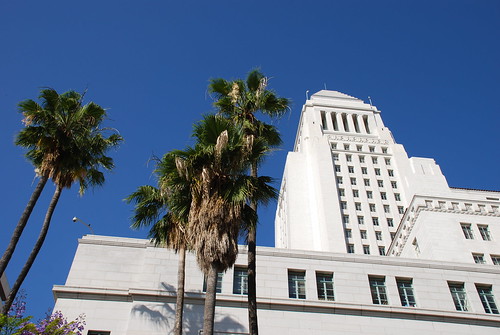
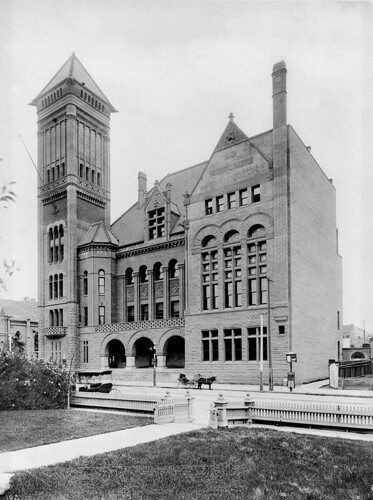
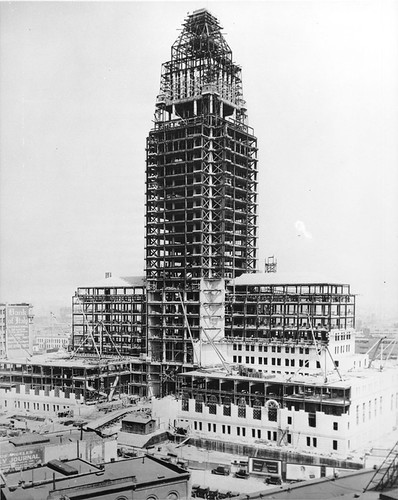
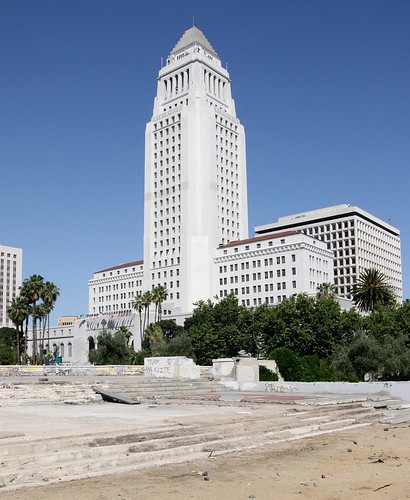
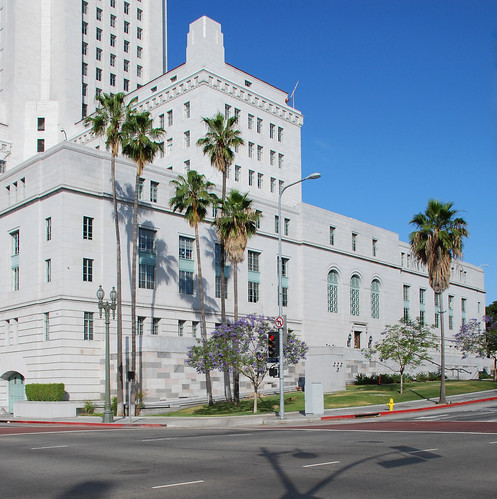
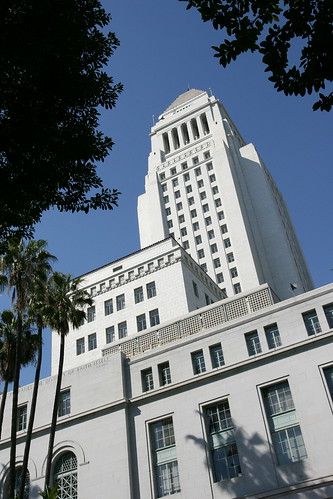
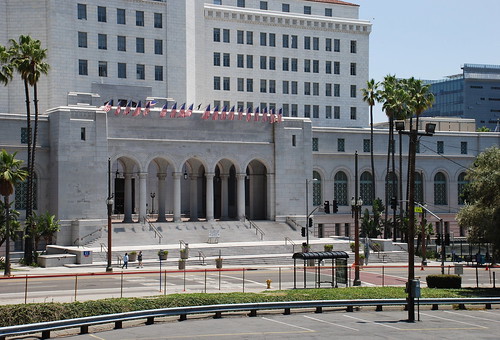
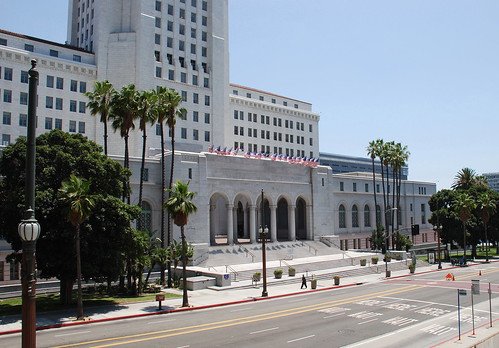
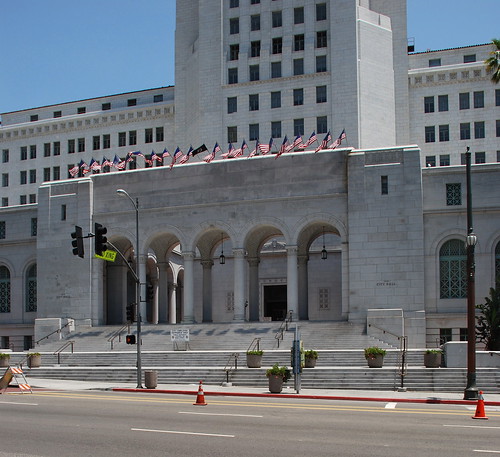
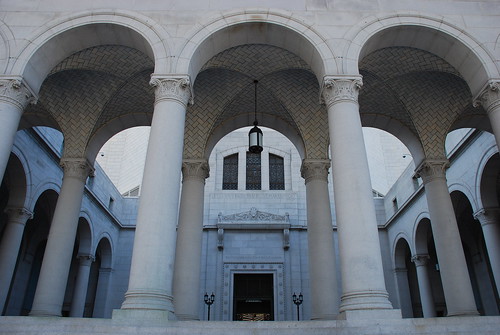
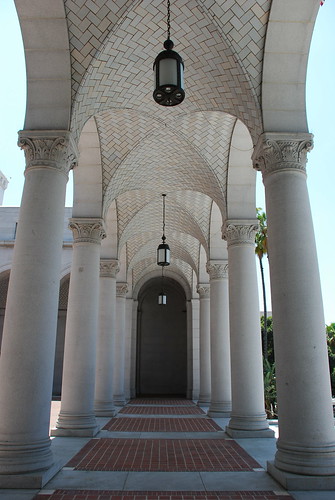
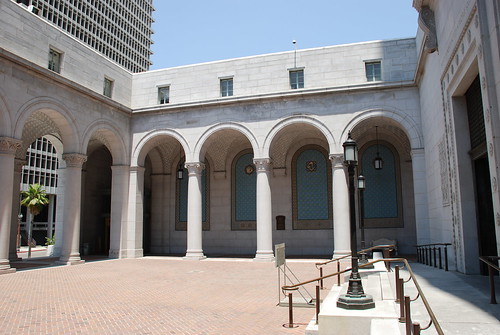
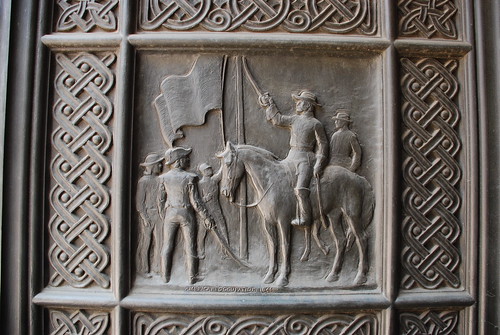
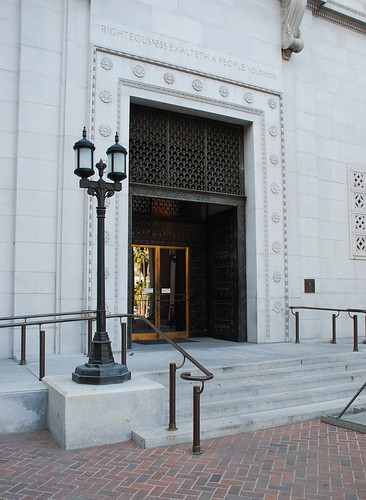
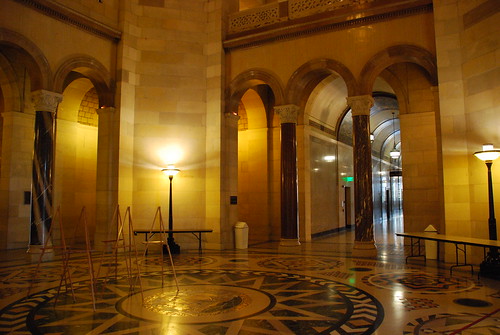
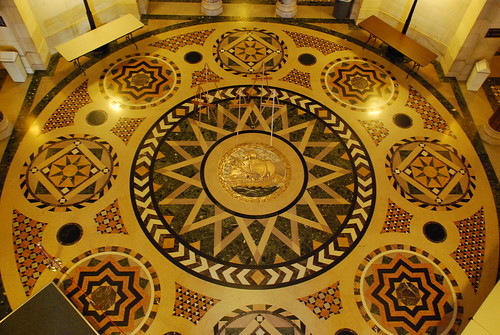
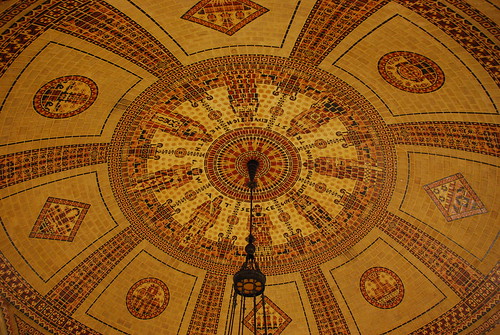
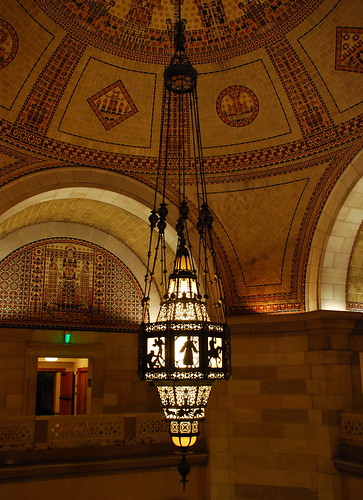
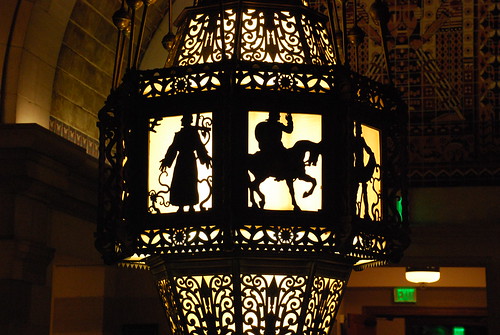
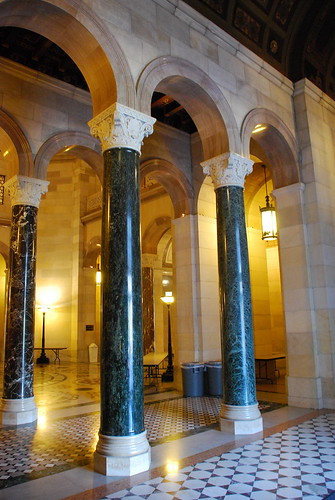
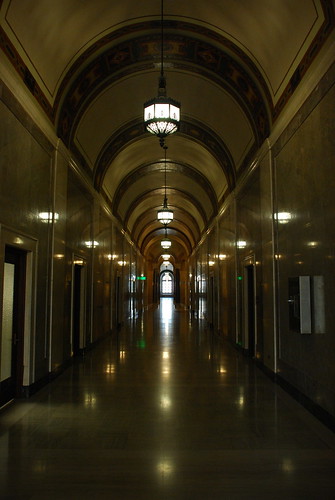
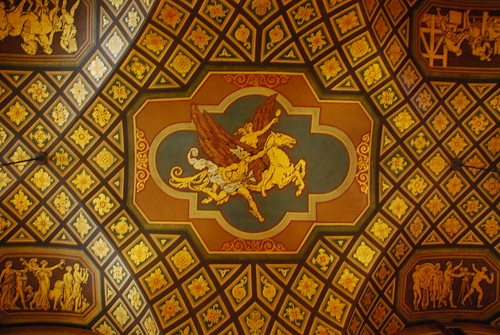
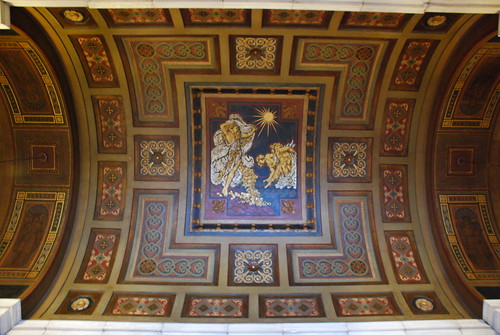
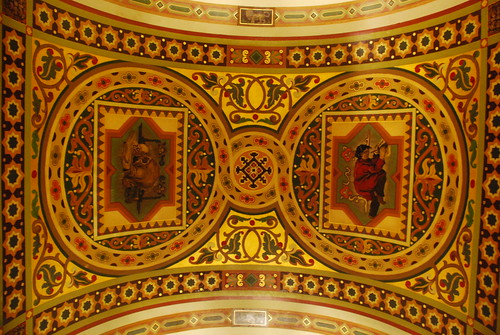
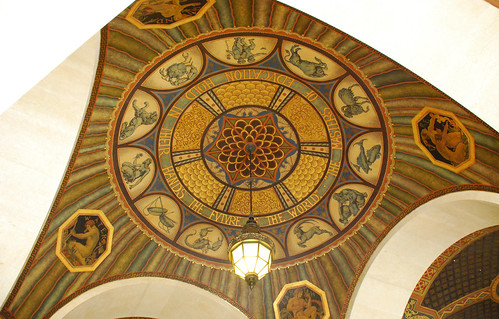
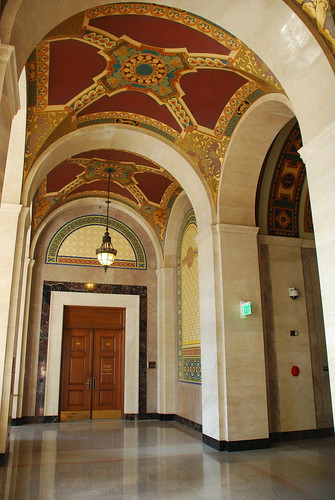
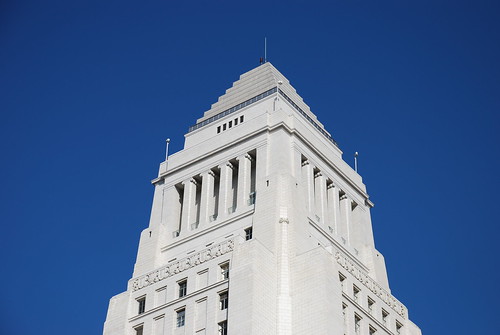
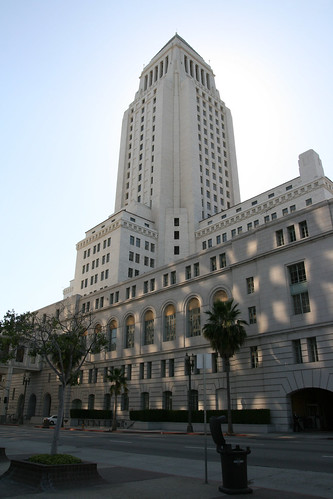
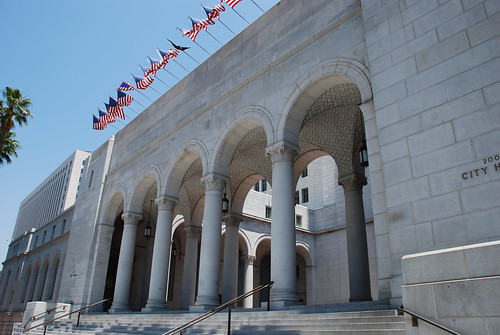
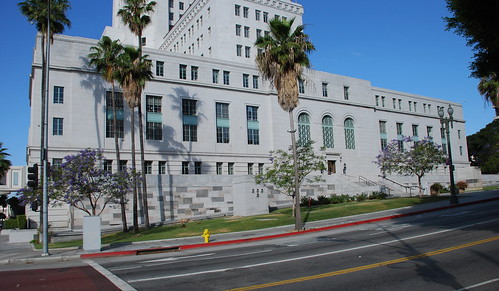
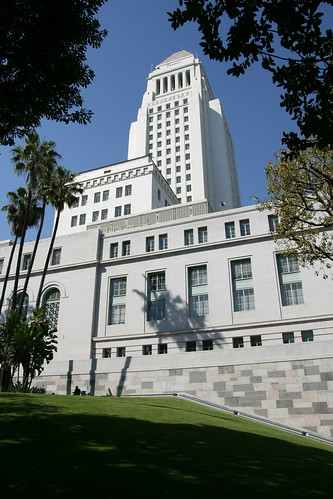

18 comments:
Hello Floyd -- Being a native or Angeleno (also Angelino), I’ve seen the city hall outside many times, but I’ve never had a reason or taken the time to enter the building. I must plan a trip sometime soon to do so. (Thanks for the tip about U-Turns). I think of this structure as the country cousin to the Empire State Building. Though diminutive in height and without the needle at the top, I see a resemblance or similarity in style. Aside from that, our city hall does have something unique about it of which your readers may or may not be aware. Not long ago, I was driving south on the old Pasadena stretch of the 110 freeway and I took the Chinatown exit when I saw the “Lindberg Light.” As you no doubt know, but for your readers, the Lindberg Light is a beacon that shoots straight up from the top of the building. It was used for air navigation in the early days of air travel from the 1920’s to WWII or 1942. Like a light house beacon for mariners, it served to show pilots they’d found Los Angeles. Happily, the light was found in a warehouse and restored in the early 1990’s and is now turned on for special occasions. It is a treat to see it and to know what it is you are seeing. Just like the Coliseum torch, which is only fired up on occasion. Incidentally, the torch may be on again soon. It’s usually on during the Olympics, wherever they may be. -- Robert
Thanks, Robert. I haven't seen the Lindbergh Light, yet. However, when I think of the building, I always imagine it in black and white with the Light lit.
Higher than City Hall, eh?
Well….strictly speaking, although the 1955 Pereira + Luckman Union Oil Center at Fifth and Beaudry was a height-limit building, it was actually higher than City Hall because it was on a hill.
But it was United California Bank who put up the Claude Beelman-designed 18-story highrise at 6th and Spring after the 13-story height-limit ban was nixed in ’57…
I've sometimes seen the beacon lit on late nights on my way home from Disneyland. Brings back the old Los Angeles feeling to downtown again.
When I first started traveling to Los Angeles in the 1970s I had no idea that City Hall was the Metropolis Daily Planet building in The Adventures of Superman. Driving down the freeway one day I almost crashed when I saw it, it was that familiar. It's one of my handful of favorite LA landmarks. Thanks Floyd.
You're welcome, Fred. And thanks, Family Be*!
I haven't been inside City Hall since I was a kid and I've forgotten how gorgeous it is! Thanks for the great pictures. It's quite the gem.
In 1962, I lived in Sierra Madre. My dad had to go into L.A. on a business trip one day, and took me along. As we drove through downtown, we saw some of the Presidential Conference Car electric trolleys, rolling along in their last months before retirement. After my dad was finished with business, we went to City Hall and rode up to the observation floor. Looking out over the city, there was hardly anything at that time that rivaled City Hall in height. Inside, there was a small museum of artifacts from California prehistory and history. I distinctly remember a long glass case containing ancient human skulls.
Skulls? Probably of reformers during the Shaw administration.
Hi Floyd
Thanks for the credit to Austin Whittlesey for the interior design.
I am his first child and knew of the story growing up in Pasadena - our home from 1924 - but find almost no historical mention of his name in connection with this famous building.
Dad studied in North Africa during his college years as a Rohdes Scholar - thus, the Byzantine (Moorish)excellence.
Regarding reform Mayor Fletcher Bowron's 1953 tragic incident with illegal alien's. What country were they from? Did they happen to be from Europe? Were they of White origin? You are not equating illegal with Mexican are you?
Regarding reform Mayor Fletcher Bowron's 1953 incident with illegal aliens, were these illegal's from Canada,Italy,Denmark,Germany,England,ect.? Or do you think that illegal aliens all come from Mexico? We did not cross the border , the border crossed us!
My great uncle, George Watson came up with the idea for the Lindberg Light. He was a newspaper photographer during the 20s and 30s. A plaque with his name, photo and the story behind the Lindberg Light was on display in the City Hall. Don't know if it still is, but I saw a reproduction of the plaque that hung in his home on Lido Isle. My uncle was a wonderful man, hard as nails when it came to his work. RIP Uncle George!
Thanks for that comment about your Uncle George, md. That sort of thing is good to learn about.
Mr grandfather was very ivolved with the building, and design of the City Hall. My father, John T. Hales and I have given the city the original photos of my granfathers book to the chief custodian of the records of the history of the City Hall and they are not for circulation, but they do exist. When I was a boy my granfather walked me through the City Hall and told me about the archtecture and how it was merged with history, exploration and mans hopes for the future. In his lifetime he saw the first flightof the Wright brothers and saw via television man landing on the moon. When you next visit City Hall look around you of the past, the then present, and the dreams for a future.
Hello! Used your site for background information on City Hall for a tour guide. I was impressed at the pictures inside city hall posted. Thank you ...
Hi, Juliana, and you are very welcome. Thanks for the nice compliment.
Post a Comment